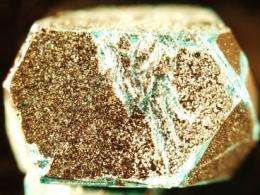New kind of magnetism discovered: Experiments demonstrate 'quantum spin liquid'

Following up on earlier theoretical predictions, MIT researchers have now demonstrated experimentally the existence of a fundamentally new kind of magnetic behavior, adding to the two previously known states of magnetism.
Ferromagnetism—the simple magnetism of a bar magnet or compass needle—has been known for centuries. In a second type of magnetism, antiferromagnetism, the magnetic fields of the ions within a metal or alloy cancel each other out. In both cases, the materials become magnetic only when cooled below a certain critical temperature. The prediction and discovery of antiferromagnetism—the basis for the read heads in today's computer hard disks—won Nobel Prizes in physics for Louis Neel in 1970 and for MIT professor emeritus Clifford Shull in 1994.
"We're showing that there is a third fundamental state for magnetism," says MIT professor of physics Young Lee. The experimental work showing the existence of this new state, called a quantum spin liquid (QSL), is reported this week in the journal Nature, with Lee as the senior author and Tianheng Han, who earned his PhD in physics at MIT earlier this year, as lead author.
The QSL is a solid crystal, but its magnetic state is described as liquid: Unlike the other two kinds of magnetism, the magnetic orientations of the individual particles within it fluctuate constantly, resembling the constant motion of molecules within a true liquid.
Finding the evidence
There is no static order to the magnetic orientations, known as magnetic moments, within the material, Lee explains. "But there is a strong interaction between them, and due to quantum effects, they don't lock in place," he says.
Although it is extremely difficult to measure, or prove the existence, of this exotic state, Lee says, "this is one of the strongest experimental data sets out there that [does] this. What used to just be in theorists' models is a real physical system."
Philip Anderson, a leading theorist, first proposed the concept in 1987, saying that this state could be relevant to high-temperature superconductors, Lee says. "Ever since then, physicists have wanted to make such a state," he adds. "It's only in the past few years that we've made progress."
The material itself is a crystal of a mineral called herbertsmithite. Lee and his colleagues first succeeded in making a large, pure crystal of this material last year—a process that took 10 months—and have since been studying its properties in detail.
"This was a multidisciplinary collaboration, with physicists and chemists," Lee explains. "You need both … to synthesize the material and study it with advanced physics techniques. Theorists were also crucial to this."
Through its experiments, the team made a significant discovery, Lee says: They found a state with fractionalized excitations, which had been predicted by some theorists but was a highly controversial idea. While most matter has discrete quantum states whose changes are expressed as whole numbers, this QSL material exhibits fractional quantum states. In fact, the researchers found that these excited states, called spinons, form a continuum. This observation, they say in their Nature paper, is "a remarkable first."
Scattering neutrons
To measure this state, the team used a technique called neutron scattering, which is Lee's specialty. To actually carry out the measurements, they used a neutron spectrometer at the National Institute of Standards and Technology (NIST) in Gaithersburg, Md.
The results, Lee says, are "really strong evidence of this fractionalization" of the spin states. "That's a fundamental theoretical prediction for spin liquids that we are seeing in a clear and detailed way for the first time."
It may take a long time to translate this "very fundamental research" into practical applications, Lee says. The work could possibly lead to advances in data storage or communications, he says—perhaps using an exotic quantum phenomenon called long-range entanglement, in which two widely separated particles can instantaneously influence each other's states. The findings could also bear on research into high-temperature superconductors, and could ultimately lead to new developments in that field, he says.
"We have to get a more comprehensive understanding of the big picture," Lee says. "There is no theory that describes everything that we're seeing."
Journal information: Nature
Provided by Massachusetts Institute of Technology





















